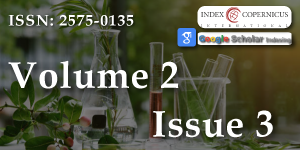Primer Pairs for Rice (Oryza sativa L.) Bisulfite Sequencing Studies
Main Article Content
Abstract
Many agriculturally important properties such as heterosis, inbreeding depression, phenotypic plasticity, and resistance for biotic and abiotic stresses are thought to be affected with epigenetic components. New discoveries related with epigenetics are likely to have a major impact on strategies for crop improvement in rice breeding. However, assessing the contribution of epigenetics to heritable variation in plant species still poses major challenges. Methylation of cytosine in DNA is one of the most important epigenetic mechanisms in plants. DNA methylation not only plays significant roles in the regulation of gene activity, but also it is related with genomic integrity. Although most of next generation sequencing (NGS) technologies do not require the use of target specific primer pairs to identify and study DNA cytosine methylation, validation studies of NGS uses selective primer pairs. Bisulfite sequencing technique is a gold method for DNA cytosine methylation studies. However, bisulfite sequencing requires the development of bisulfite primer pairs to selectively study DNA sequences of interest. In this study 9 bisulfite specific primer pairs were identified and validated. These primer pairs successfully amplified bisulfite converted and unconverted genomic DNA extracted from radicle and plumule of rice (Oryza sativa L.) seedlings. Results of the present study clearly revealed the occurrence of CG, CHG and CHH (H stands for C. T or A nucleotides) contents in studied DNA sequence targets were different indicating potential role of DNA cytosine methylation in these genes. Primer pairs reported in this study could be used to detect DNA methylation which is one of the most important epigenetic mechanisms affecting the development, differentiation or the response to biotic and abiotic stress in rice (Oryza sativa L.).
Article Details
Copyright (c) 2018 Karaca M, et al.

This work is licensed under a Creative Commons Attribution 4.0 International License.
Guo L, Liu M, Zhang Y, Tao Y, Zhang F, et al. Yield differences get large with ascendant altitude between traditional paddy and water-saving ground cover rice production system. European Journal of Agronomy. 2018; 92: 9–16. Ref.: https://goo.gl/T9AVoZ
Anonymous, USDA Foreign Agricultural Service, Global Agricultural Information Network Report. 2017; No: TR7014. Ref.: https://goo.gl/44h7Dc
Anonymous, FAOSTAT Food Agricultural Organization. 2018; UN. Ref.: http://faostat.fao.org/
Deng X, Song X, Wei L, Liu C, Cao W. Epigenetic regulation and epigenomic landscape in rice. National Science Review. 2016; 3: 309–327. Ref.: https://goo.gl/cwtgTq
Law JA, Jacobsen SE. Establishing, maintaining and modifying DNA methylation patterns in plants and animals. Nature Reviews Genetics. 2010; 11: 204-220. Ref.: https://goo.gl/73Le67
Shen H, He H, Li J, Chen W, Wang X, et al. Genome-wide analysis of DNA methylation and gene expression changes in two Arabidopsis ecotypes and their reciprocal hybrids. Plant Cell. 2012; 24: 875-892. Ref.: https://goo.gl/WQyeY6
Peng H, Zhang J. Plant genomic DNA methylation in response to stresses: potential applications and challenges in plant breeding. Progress in Natural Science. 2009; 19: 1037-1045. Ref.: https://goo.gl/Cs1Y5Z
Karaca M, Ince AG. EpiOne: A software tool for identification of potential cytosine DNA methylation marks in promoters and gene bodies. Journal of Scientific and Engineering Research. 2016; 3: 295-301. Ref.: https://goo.gl/Jpt7Nx
Jin X, Pang Y, Jia F, Xiao G, Li Q, Zhu Y. A potential role for CHH DNA methylation in cotton fiber growth patterns. PLoS ONE. 2013; 8: e60547. Ref.: https://goo.gl/AAwGBH
Rozen S, Skaletsky H. Primer3 on the WWW for general users and for biologist programmers. Methods in Molecular Biology. 200; 132: 365-386. Ref.: https://goo.gl/fSisb9
Karaca M, Ince AG, Elmasulu SY, Onus AN, Turgut K. Coisolation of genomic and organelle DNAs from 15 genera and 31 species of plants. Anal Biochem. 2005; 343: 353-355. Ref.: https://goo.gl/NGZn1Y
Karaca M, Ince AG, Uygur-Gocer E, Aydin A. Bisulfite primer pairs for analysis of cotton (Gossypium spp.) DNA methylation. Journal of Scientific and Engineering Research. 2016; 3: 656-662. Ref.: https://goo.gl/VPJcV6
Gruntman E, Qi Y, Slotkin RK, Roeder T, Martienssen RA, Sachidanandam R. Kismeth: analyzer of plant methylation states through bisulfite sequencing. BMC Bioinformatics. 2008; 9: 371. Ref.: https://goo.gl/9qVRHL
Bewick, AJ, Schmitz RJ. Gene body DNA methylation in plants. Current Opinion in Plant Biology. 2017; 36: 103-110. Ref.: https://goo.gl/Yfb22X
Yonekura M, Aoki N, Hirose T, Onai K, Ishiura M, et al. The promoter activities of sucrose phosphate synthase genes in rice, OsSPS1 and OsSPS11, are controlled by light and circadian clock, but not by sucrose. Frontiers in Plant Science. 2013; 4:31. Ref.: https://goo.gl/gcEN6h
Nelson AJ, Doerner PW, Zhu Q, Lamb C. Isolation of a monocot 3-hydroxy-3-methylglutaryl coenzyme A reductase gene that is elicitor-inducible. Plant Molecular Biology. 1994; 25: 401-412. Ref.: https://goo.gl/AppLJJ
Liu DR, Huang WX, Cai XL. Oligomerization of rice granule-bound starch synthase I modulates its activity regulation. Plant Science. 2013; 210: 141-150. Ref.: https://goo.gl/wo9Vad
Ince AG, Karaca M, Uygur Gocer E, Aydin A. Descriptive statistics and PIC values of genomic-and transcriptomic-microsatellites in several plant species. Journal of Scientific and Engineering Research. 2017; 4:236-246. Ref.: https://goo.gl/cLGgeS
Chen X, Zhou DX. Rice epigenomics and epigenetics: challenges and opportunities. Curr Opin Plant Biol. 2013; 16:164-169. Ref.: https://goo.gl/Y9qAqr

